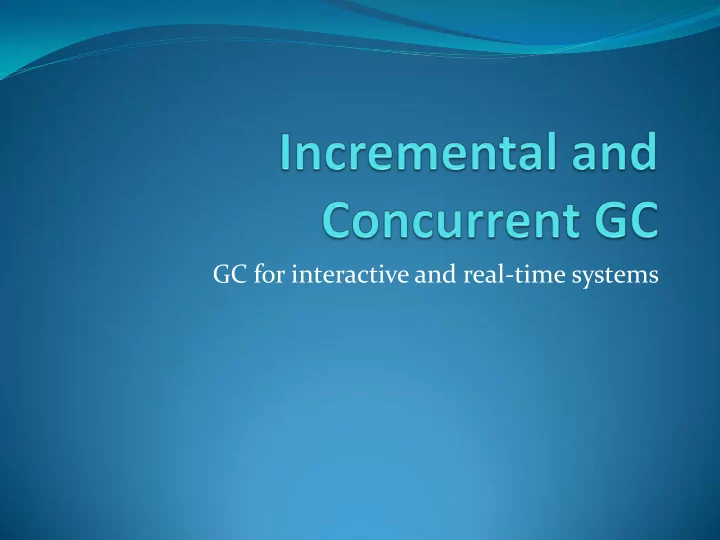

GC for interactive and real-time systems
Interactive or real-time app concerns Reducing length of garbage collection pause Demands guarantees for worst case performance Generational GC works if: Young generation is relatively small Survival rate of objects is sufficiently low 2
Interactive or real-time app concerns Generational GC does not work if Does frequent major collections Survival rate is high Attempts to improve expected pause time At expense of worst case 3
A turn to incremental techniques Simplest is RCGC Naturally incremental for all operations except Deletion of last ptr to an object However, recursive freeing can be circumvented 4
Hardware focus Sequential architectures A task runs to completion on single processor Shared memory multiprocessors May need locks on certain resources or parts of code Synchronization very expensive 5
Incrementalizing sequential GC Interleave GC with mutator GC must make sufficient progress Else mutator will run out of memory Tune GC rate with rate of memory consumption: Do a small amount of marking/copying with each allocation To prevent mutator from running out of memory additional headroom is needed 6
Tuning GC rate To prevent mutator from running out of memory additional headroom is needed R = # active words in heap at start of collection K = # words traced at each allocation Need R/K calls to allocator to mark all active words At most R(1 + 1/K) live objects at end of tracing Memory needed to prevent mutator starvation 7
Does incremental mean real-time Hard real-time: Results must be computed on time Late result is as useless as incorrect result Require worst-case guarantees NOT average case Most demand space bounds, avoid virtual memory Soft real-time: Prefers that results are on time Late results better than no results at all Many so called real-time GC cannot realistically meet worst-case deadline for hard real-time systems They offer average case pause times 8
The need for synchronization Asynchronous execution Independent execution of two or more process in a multitasking system Execution of a process "in the background". Other processes may be started before an asynchronous process has finished Garbage collector Can run as its own process (thread) Can have fixed interleaving within single sequential process Introduces inconsistency in status of heap objects 9
Synchronization defined Timekeeping which requires the coordination of events to operate a system in unison System must be in sync The coordination of simultaneous threads or processes to complete a task In order to obtain correct runtime order and avoid unexpected race conditions 10
Synchronization example root update(right(B), right(A)) A B right(A) = NULL step 1 update(right(A), right(B)) right(B) = NULL step 2 C root root A B A B C C Step 1 Step 2 11
Coherence problem Incremental mark-sweep collector Poses multiple-readers, single writer coherence problem Both mutator and collector read pointers Only mutator modify (write) pointers Incremental copy collector Poses multiple-readers, multiple-writers problem Collector also writes pointers when it moves objects Mutator’s view of the world must be consistent Collector has conservative view of reachability graph Treat some unreachable objects as if they are reachable 12
Conservative collection GC and mutator do not need to have same view of reachability graph Introduces floating garbage Became unreachable during last GC cycle Will be collected during next cycle Fragments heap Increases effective residency of program Puts pressure on GC 13
Judging incremental collectors Degree of conservatism is one parameter Bounds on mutator pause GC must delay computation briefly at each step to make progress Contain uninterruptible sections (increments) Process root set Check for termination of GC cycle 14
Tricolor abstraction Used for copying collection Used with Lin’s algorithm (4 colors) for reclaiming cycles Was originally introduced by Dijkstra to describe incremental collection Black Grey White GC cycle terminates when all reachable objects are colored black 15
Tricolor marking Black: • Object and immediate descendents have been visited • GC finished with these objects; don’t have to visit them again White: • Objects not visited, are garbage at end of tracing phase Gray: • Object must be visited by collector • Object visited by collector but descendants have not been scanned • Object whose connectivity to rest of graph has been altered by mutator behind collector’s back 16
Synchronization example root update(right(B), right(A)) A B right(A) = NULL step 1 update(right(A), right(B)) right(B) = NULL step 2 C root root A B A B C C Step 1 Nodes A or C should be colored grey. Step 2 17
Using barriers Mutator can disrupt GC by writing to black objects Introducing black to white pointers How to prevent this? Ensure mutator never sees white objects Need to protect white objects with read barrier Record where mutator writes pointers to white objects in black objects Protect objects concerned with write barrier (mark them grey) Collector re/visits objects concerned 18
Falsely reclaiming objects Object must be visible to mutator but invisible to collector Both of these conditions for failure must hold (during marking phase) for this to happen A pointer to a white object must be written in a black object This must be the only ref to white object Original ref to white object must be destroyed Write barrier methods solve mutator-collector communication problem tackle at least 1 condition of failure 19
Recommend
More recommend